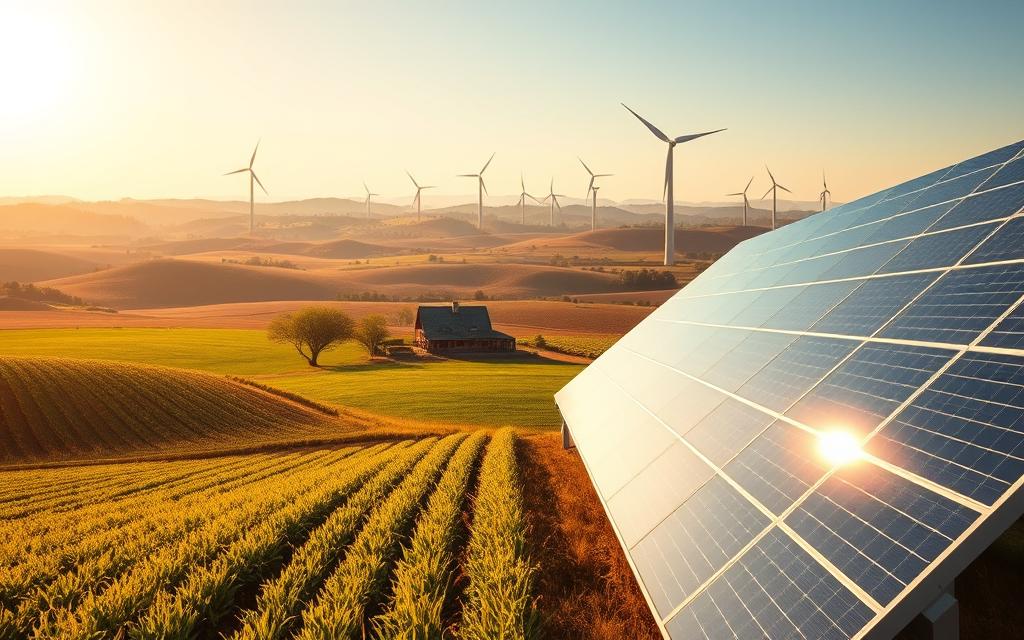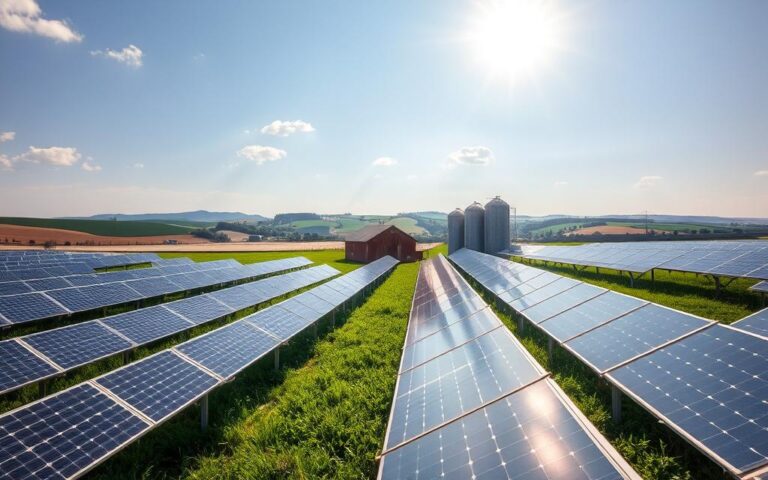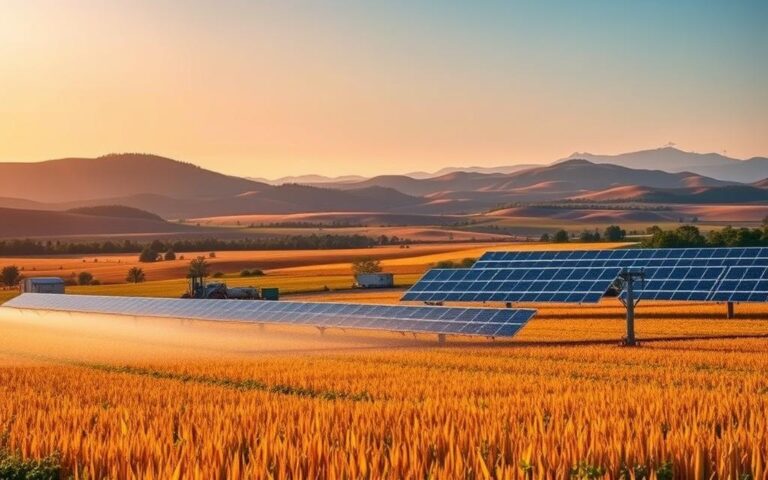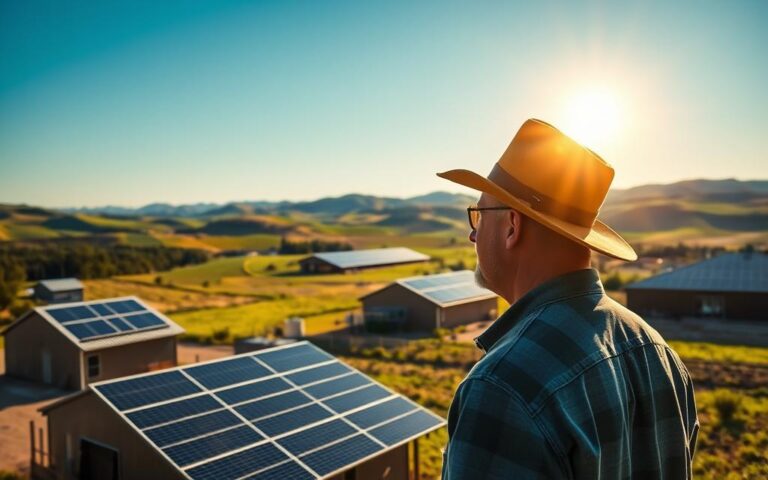Did you know that farms in the United States can cut their energy costs by up to 50% with solar power? USDA solar incentives help farmers make their operations more profitable. The U.S. Department of Agriculture offers financial help through programs like the federal solar rebate program, grants, and loans.
By using solar energy, landowners can reach their sustainability goals and earn money from energy production. These green energy grants and subsidies make it easier to switch to solar. Knowing about these incentives is key for farmers to get the most economic and environmental benefits.
Understanding Solar Energy for Agriculture
Solar energy is changing how farmers work, making it both good for the wallet and the planet. It’s not just about saving money. It also makes farming more efficient and can even bring in extra cash.
The Benefits of Solar Energy for Farmers
Farmers who use solar energy save a lot on electricity. This is a big help for their finances. Solar panels power important tasks like watering, drying, and heating.
This move cuts down on fossil fuel use. It also helps keep costs steady when energy prices go up. Plus, farmers can get help from government subsidies, making things even better.
How Solar Energy Can Increase Profitability
Solar energy can also make farmers money. They can sell extra energy to the grid through net metering. This gives them two ways to earn, while also being green.
With government subsidies, investing in solar panels is a smart choice. It boosts profits and helps the environment at the same time.
Types of Solar Panel Ownership
Farmers have two main options for solar panel ownership: direct ownership and third-party ownership. Each choice has its own financial benefits and drawbacks. These can affect how profitable and sustainable solar energy systems are for farmers.
Direct Ownership vs. Third-Party Ownership
Direct ownership means farmers buy the solar system themselves. This gives them full control over the equipment. They can get tax credits, like the Investment Tax Credit (ITC), which is a big plus.
By owning the system, farmers save money on energy costs over time. They can also upgrade their system in the future. But, third-party ownership has its own benefits. It means farmers don’t have to pay for the system upfront.
Instead, they pay a monthly lease or power purchase agreement (PPA). This option can lower initial costs. Yet, it might mean missing out on tax incentives.
Financial Implications of Each Ownership Type
The costs and benefits of each ownership type differ. Direct ownership costs more upfront but saves money in the long run. Farmers can use tax credits to boost their investment returns.
Third-party ownership, on the other hand, saves money right away. But, it might not offer the same long-term financial gains. This is because farmers miss out on tax credits and could see lease payments increase over time.
What are USDA Solar Incentives?
The USDA solar incentives help farmers and small businesses use renewable energy like solar. The Rural Energy for America Program (REAP) is key to this effort. It offers grants and loans to make renewable energy projects more affordable.
Overview of the Rural Energy for America Program (REAP)
REAP gives financial help for renewable energy projects. It helps farmers and small businesses in agriculture. This way, they can use clean energy and improve their energy use.
Eligible Projects Under REAP
REAP funding supports many renewable energy projects. These include:
- Solar energy installations
- Wind energy projects
- Hydropower projects
- Energy efficiency improvements
Eligible projects can get up to $500,000 for renewable energy. Up to $250,000 is available for energy efficiency upgrades. This makes it easier for businesses to go green.
How to Apply for USDA Solar Incentives
To apply for USDA solar incentives, follow these steps:
- Check if you meet the eligibility criteria, focusing on agricultural income.
- Gather documents that show your project’s details and energy savings.
- Apply through the USDA office, following the deadlines and rules.
Tax Credits Available for Solar Installations
Understanding the financial benefits of solar installations is key for farmers. Tax incentives help lower the costs of solar energy systems. Solar panel tax credits are especially important for investing in renewable energy.
Investment Tax Credit (ITC)
The Investment Tax Credit (ITC) lets businesses deduct a big part of solar system costs from taxes. Right now, you can get a 30% deduction on solar panel costs. This credit helps make solar energy more sustainable and financially smart for farmers.
Modified Accelerated Cost Recovery System (MACRS)
The Modified Accelerated Cost Recovery System (MACRS) helps speed up cost recovery. It lets businesses write off solar equipment costs faster. This means less tax burden and more incentive to use solar in farming.
Understanding Federal Solar Tax Credits
Federal solar tax credits, like the ITC and MACRS, make solar installations more affordable for farmers. These incentives boost operational efficiency and support sustainability. They also help reduce emissions and improve financial stability.
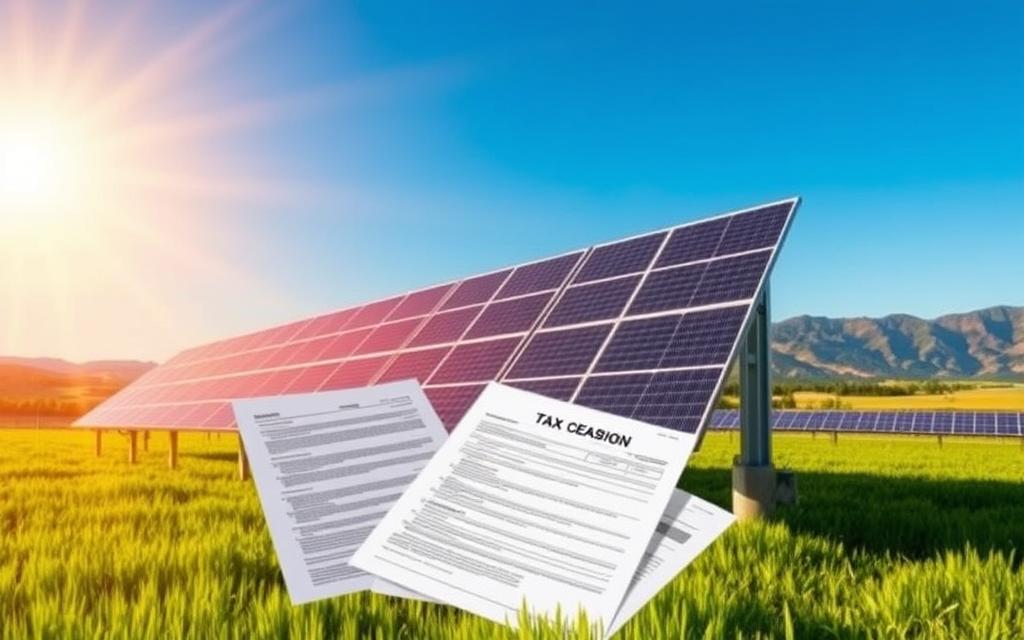
Agrovoltaics: Combining Solar and Agriculture
Agrivoltaics is a new way to use land for both solar energy and farming. It lets farmers grow crops under solar panels. This approach makes the most of land and offers big benefits for farmers and food systems.
The Concept of Dual-Use Land
Dual-use land means using the same area for farming and solar energy at the same time. This way, farmers can use solar energy in their work while keeping up with traditional farming. It helps manage resources better and reduces land pressure.
Benefits of Agrivoltaics for Farmers
Farmers who use agrivoltaics get many advantages, including:
- Increased Crop Yields: Solar panels offer shade, which protects crops from harsh weather and helps them grow better.
- Water Conservation: Solar panels cut down on water loss, making water use more efficient.
- Diverse Revenue Streams: Farmers can earn money from crops and by selling electricity to the grid.
- Enhanced Resilience: This method helps farmers deal with climate change, making farming more stable and sustainable.
In short, agrivoltaics is a smart choice for farmers. It boosts productivity and supports renewable energy.
| Benefit | Description |
|---|---|
| Increased Crop Yields | Shade from solar panels can help protect crops from excessive heat and improve growth rates. |
| Water Conservation | Reduction in evaporation helps conserve water resources essential for farming. |
| Diverse Revenue Streams | Farmers can sell agricultural products while generating electricity, providing an additional income source. |
| Enhanced Resilience | Adopting these strategies helps farmers adapt to changing climate conditions and market demands. |
Financial Assistance for Solar Projects
Looking into financial help for solar projects can really help farmers choose green options. There are many ways to get funding, like solar grants and loans with low interest. Knowing about these can make it easier for farmers to use solar energy on their land.
Understanding Grants and Loans
Grants are great because you don’t have to pay them back. Many federal and state programs give out solar grants for farming. Loans are another good choice, with special terms for green energy projects.
These options help farmers start using solar energy without worrying too much about the cost at first.
Other Funding Opportunities Beyond USDA
There’s more help out there than just USDA programs. Community groups and private investors also offer support. Some states have their own grant programs to help with solar projects.
Farmers should really look into all the funding options available. This way, they can get the most out of these chances to go green.
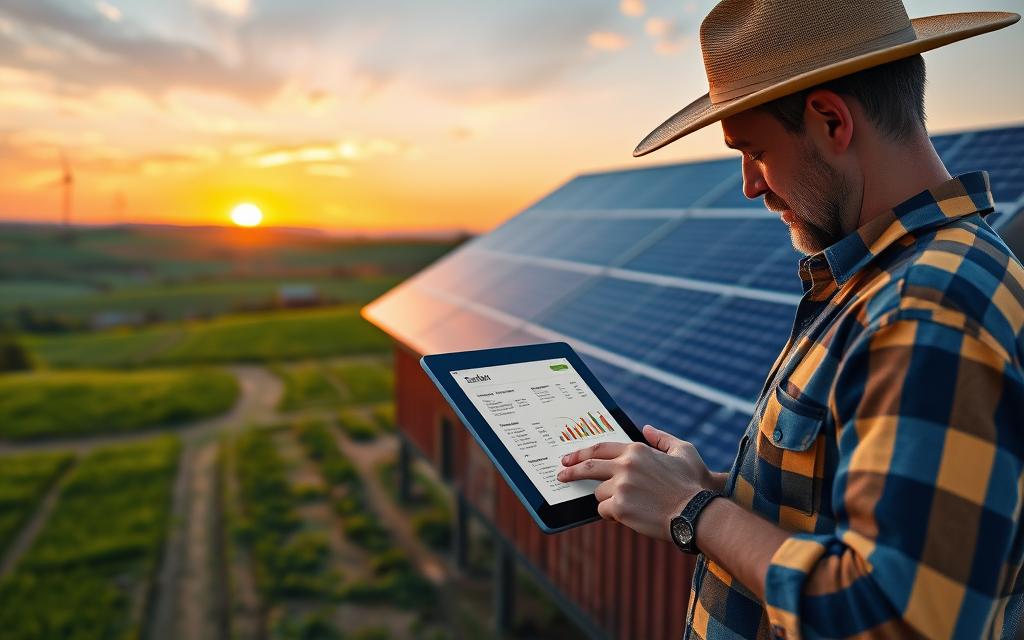
How to Get Started with Solar Installations
For farmers looking to start solar installations, a clear process is key. Understanding the need for an energy audit is the first step. An energy audit helps farmers see how much energy they use and where they can save.
This info is crucial for picking the right solar system size. It must match the farm’s specific needs.
The Importance of an Energy Audit
The energy audit is the base of any solar project. It shows where energy is used and how to use it better. By knowing their energy needs, farmers can choose the best solar solutions.
Skipping this step can lead to solar systems that are too big or too small. This can lower efficiency and raise costs.
Steps to Begin Your Solar Journey
After the energy audit, farmers can start their solar project. Here are the main steps:
- Researching reputable solar contractors with experience in agricultural projects.
- Obtaining multiple quotes to compare services and costs.
- Ensuring compliance with local regulations and permitting requirements.
- Choosing a financing option that aligns with the farm’s budget and goals, such as loans or grants.
- Planning for the installation process, including timelines and potential impacts on farm operations.
Each step is important for a successful solar installation. It ensures the farm gets sustainable and profitable energy solutions.
Maximizing Your Solar Incentive Applications
Getting solar grants like the REAP program needs careful work. You must pay close attention to your grant documents. It’s important to show your financial needs and project goals clearly.
Farmers need to gather accurate and detailed records. These records help show you’re eligible and have a solid financial plan.
Documentation Requirements for Grant Applications
To do well in grant applications, focus on a few key things:
- Detailed financial records of previous expenses
- Supporting documents that validate project eligibility
- A clear outline of project objectives and community benefits
- Comprehensive project plans including timelines and estimated costs
Best Practices to Improve Application Success
Using the right strategies can boost your chances of getting approved. Here are some tips:
- Work with experts in grant writing to make your application better
- Use tools like FarmRaise Tracks to keep your documents organized
- Show how your project is needed and will help the community
Conclusion
The USDA solar incentives play a big role in making solar energy a reality for farmers. These programs help farmers switch to renewable energy, saving money and making more money. It’s a win-win situation.
Using solar energy is good for the planet and for farming. It makes farming more eco-friendly. As people learn more about solar energy, farmers can use new technologies to help the environment and their farms.
Solar energy has the power to change farming for the better. With USDA help and the right knowledge, farmers can make their farms more sustainable and profitable. This is a big step towards a greener and more successful future in farming.

